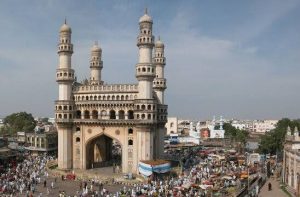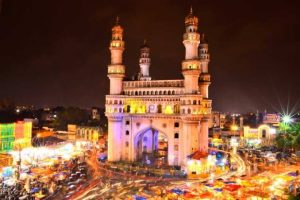Digital News Guru Hyderabad Desk:
The Charminar, located in the heart of Hyderabad, India, is one of the most iconic monuments of the country, standing as a testament to the city’s rich history, culture, and architectural brilliance. This magnificent structure, with its four grand arches and towering minarets, has become a symbol not just of Hyderabad, but of the cultural and architectural fusion that defines the Deccan region. This article explores the Charminar’s origins, architectural features, historical significance, and its place in contemporary Hyderabad.
Origins and Historical Context
The Charminar was built in 1591 by Sultan Muhammad Quli Qutb Shah, the fifth ruler of the Qutb Shahi dynasty, to mark the founding of the city of Hyderabad. According to local legends, the Sultan built the structure as a gesture of gratitude and to commemorate the end of a devastating plague that had ravaged the region. The name “Charminar” is derived from the words “Char” (four) and “Minar” (tower), referring to the four grand minarets that adorn the structure.

Historically, the Charminar was not just an architectural marvel, but also served as the center of the Qutb Shahi dynasty’s rule. It was positioned strategically to be at the crossroads of the main roads leading to the old city, signifying its importance as both a landmark and a functional space. The area surrounding the Charminar has evolved into a vibrant market area, home to Laad Bazaar (famous for its bangles) and several other traditional bazaars that reflect the city’s rich cultural diversity.
Architectural Brilliance
The Charminar is an exquisite example of Islamic architecture, with distinct influences from Persian, Mughal, and Hindu designs. The structure is made of granite and lime mortar, which were the primary materials used in the era. The monument stands at a height of 56 meters and features four grand arches facing the cardinal directions: north, south, east, and west. These arches open into the busy streets of the city, symbolizing the Charminar’s role as the heart of Hyderabad.
At each corner of the structure, there are four 24-meter-tall minarets, which rise from a square base. These minarets are adorned with beautiful stucco decoration and are topped with domes that add to the monument’s grandeur. The overall design incorporates Persian-style arches and Mughal-style domes, with detailed stone carvings that include floral motifs, geometric patterns, and calligraphy. This unique fusion of architectural styles marks the Charminar as a symbol of the cultural amalgamation prevalent during the time of the Qutb Shahis.
The Charminar’s Significance in Hyderabad
Over the centuries, the Charminar has transcended its role as a mere architectural structure, becoming a living symbol of Hyderabad. It embodies the city’s historic journey from its medieval origins to its modern-day status as one of India’s most vibrant cities. The Charminar is a reminder of the Qutb Shahi dynasty’s contributions to the region’s architecture, urban planning, and culture.

Today, the Charminar remains an important landmark for both locals and tourists alike. It is a symbol of Hyderabad’s multicultural heritage, with the bustling streets around it showcasing the city’s diverse culinary, cultural, and economic vibrancy. The monument has been a witness to the rise and fall of empires, the expansion of Hyderabad’s urban sprawl, and the growth of its modern identity. As such, the Charminar holds a central place in the heart of the people of Hyderabad.
Charminar in Modern Culture
In contemporary times, the Charminar continues to be an integral part of the cultural identity of the city. It is not only a popular tourist destination but also a symbol for Hyderabadi culture and identity. The annual celebration of festivals like Eid and Diwali sees the Charminar illuminated in a sea of lights, while the surrounding areas come alive with street food, shopping, and cultural performances.
The area around Charminar, known as the Old City, is home to a variety of cultural landmarks and heritage buildings that complement the Charminar’s majestic presence. The streets surrounding the monument are lined with vibrant markets such as the Laad Bazaar, famous for its bangles, Pather Gatti, known for its food stalls, and Chandni Chowk, offering a taste of traditional Hyderabadi shopping.
Moreover, Charminar has found its place in the global imagination, often featured in postcards, films, and literature. It has become a key visual element in marketing and branding, representing the city’s rich Islamic heritage and its cosmopolitan spirit. Its presence on the city’s skyline makes it an unmissable part of Hyderabad’s identity, drawing millions of visitors every year.

Charminar in the Modern Day
In the 21st century, the Charminar faces both challenges and opportunities. Preservation efforts are critical to maintaining the integrity of this centuries-old monument amidst the encroaching urbanization of the surrounding area. Local authorities, in collaboration with heritage organizations, have undertaken restoration projects to ensure the Charminar remains as magnificent as ever, while balancing the pressures of modern development.
One of the biggest challenges is managing the increasing foot traffic around the Charminar. With the influx of tourists, pilgrims, and locals visiting the monument daily, congestion has become an issue. However, efforts are being made to regulate the area, improve pedestrian facilities, and enhance the visitor experience.
Conclusion
The Charminar is not just a monument; it is a living, breathing symbol of Hyderabad’s history, culture, and diversity. With its architectural beauty, historical significance, and continued importance in the life of the city, the Charminar remains one of India’s most cherished landmarks. As both a cultural hub and a historical treasure, the Charminar embodies the spirit of Hyderabad and continues to inspire awe in all who visit it. Its presence is a reminder of the city’s illustrious past and its ongoing transformation into a dynamic, global metropolis.
Today, as the Charminar stands tall amidst the bustling city, it remains a symbol of resilience, heritage, and the fusion of old and new, making it a truly timeless marvel.
You May Also Read: By-Elections in Uttar Pradesh: November 20, 2024 Update








